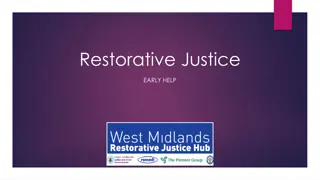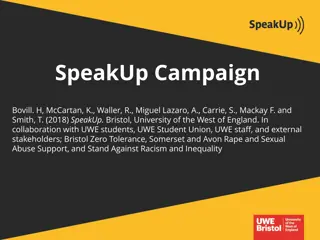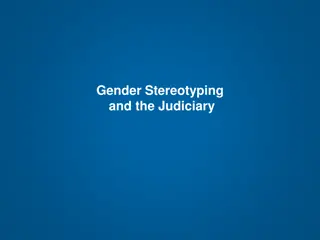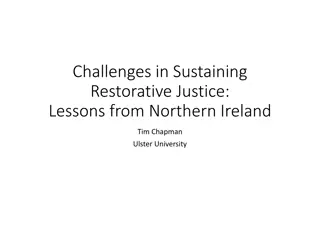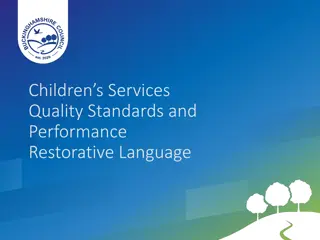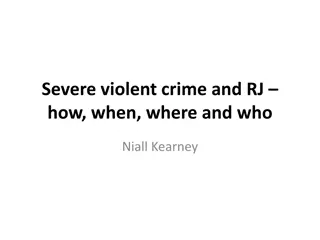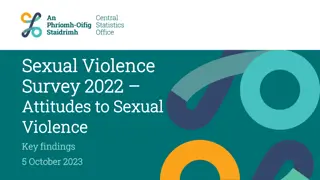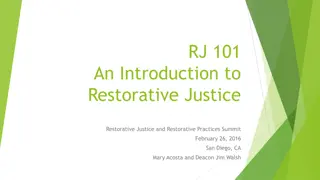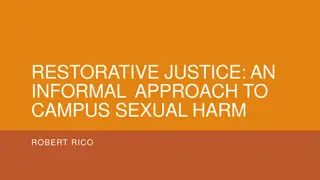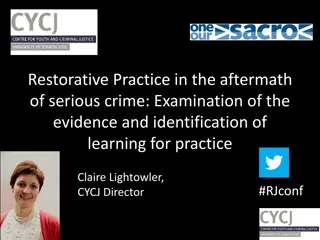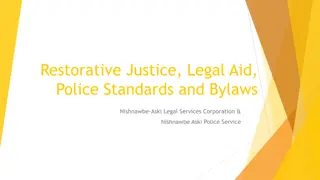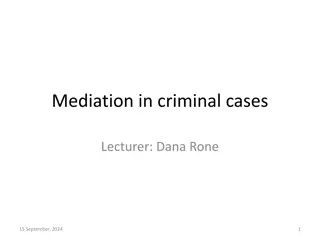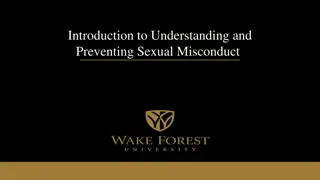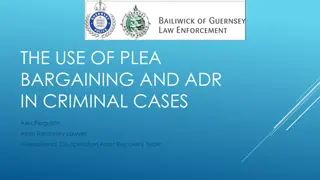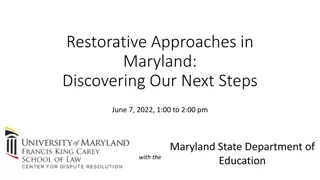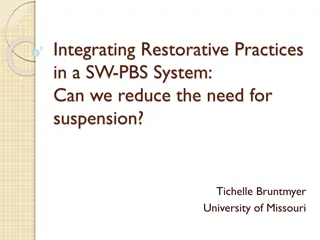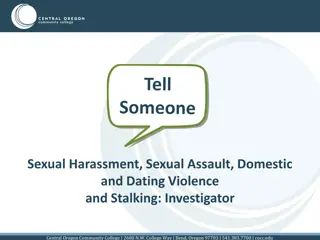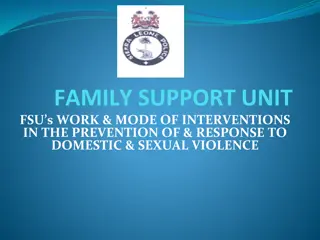Understanding Restorative Justice in Complex Cases of Sexual Violence
Explore the world of restorative justice in complex cases of sexual violence, focusing on Dr. Marie Keenan's expertise as an Associate Professor at University College Dublin. Discover the systemic and forensic perspective she brings to addressing interpersonal relationships affected by crime, highlighting the importance of justice and healing. Dive into the distinctions between restorative justice and restorative practice, considering crime as both a public and private matter.
Download Presentation

Please find below an Image/Link to download the presentation.
The content on the website is provided AS IS for your information and personal use only. It may not be sold, licensed, or shared on other websites without obtaining consent from the author. Download presentation by click this link. If you encounter any issues during the download, it is possible that the publisher has removed the file from their server.
E N D
Presentation Transcript
Restorative Justice in Complex Cases: Sexual Violence Dr Marie Keenan, Associate Professor University College Dublin marie.keenan@ucd.ie
Systemic and Forensic psychotherapist always saw people in relationship never as isolated entity Victims, Offenders, families and Networks Doing RJ before I called it that Trained in RJ at UU; Mark Umbreit [Ireland]; Janine Geske, [Ireland and US] [max security prison Wisconsin] Research focused on RJ and SV Teach about these subjects Extern Examiner - Uni Ulster for RJ Masters / Diplomas/ Certs Programmes Facilitate cases Practitioner Researcher
RJ focused on crime ; RP on everything else involving conflict outside of crime Slippage: Everything and nothing Need to keep Justice in the title of what we do in relation to / response to crime Justice: A concept based on ethics and law that means people behave in a way that is Fair; Equal and Balanced for Everyone Justice is the legal and philosophical theory by which fairness is administered Justice is an important moral and political concept Distinction: Restorative Justice and Restorative Practice ?
Public matter - violation of social norms, of penal code State on behalf of its citizens has obligations to Detect, Investigate and Prosecute wrongdoing gather evidence, try the evidence against a beyond reasonable doubt evidential threshold, punish, rehabilitate offenders Safer Societies Complainants / Victims and Accused/ Offenders have rights: Citizens have rights to have state investigate wrongdoing against them; accused persons entitled to Due Process Restorative Justice and Thinking about Crime as a Public Matter
Restorative Justice and Thinking about Crime in its Private Dimensions Crime is fundamentally a violation of people and interpersonal relationships Private or personal aspects of the problem Violations create obligations and liabilities (offender accountability); Restorative justice seeks to heal and put right the wrongs and in some cases offer forms of reparative justice. Need both Public and Private responses Formal and Informal-legitimated Justice Responses Not Either / Or . Both/And
Distinction: Restorative Justice and Mediation May be linguistic Process Dialogue Driven Outcome Driven
Truth, Core Values Core Values of of Restorative Restorative Justice Justice Justice, Solidarity, Responsibility taking, Dignity Respect
Core Principles of Restorative Justice (RJ) Applied to Sexual Violence Victim-led/ victim initiated approach Offender responsibility for the harm caused Participation on a voluntary basis Safety paramount [physical, emotional, procedural] Flexible- context and case specific Preparation, Preparation, Preparation Process rather than Event focused Training of facilitators: (1)Impact of trauma; (2)Dynamics of Power-based Crime/ Sexual Violence; (3) The Law and Due Process (as well as RJ)
Core Methodologies: Restorative Justice after Sexual Crime 1. V-O Dialogues / V-O Mediation [Direct or Indirect] Direct Face to Face Shuttle Mediation Use of Videos 2. RJ Conferences 3. Healing Circles
Participatory Flexible Addressing the harm caused Reparation Past, Present and Future Oriented Methodologies Methodologies
Encounter Amends Reintegration Inclusion Methodologies Methodologies
RJ after SV: Concerns and Responses
HOW ARE CONCERNS FOR VICTIMS ADDRESSED IN PRACTICE? Concerns Solutions in Practice Voluntary participation Right to withdraw at any time Preparation Risk assessments not to prevent participation but to inform RJ process Physical, emotional and procedural safeguards Training of facilitators Choice of direct (face-to-face) or indirect RJ Time-out mechanisms Re-victimisation Re-traumatisation Power imbalances Safety
HOW ARE CONCERNS FOR / ABOUT OFFENDERS ADDRESSED IN PRACTICE? Concerns Solutions in Practice Risk assessment not to prevent participation but to enhance and inform the RJ process Preparation Participation is voluntary Right to withdraw from RJ process any time Procedural safeguards such as confidentiality safeguards / firewall between criminal justice and restorative justice if happening in parallel Suitability of sex offenders for RJ will they manipulate process for their own ends? Due process rights: Presumption of innocence Right against self- incrimination Right to fair trial
The Inter- relationship between Restorative Justice and the Criminal Justice System Should RJ be available within, alongside or outside of the CJS? If RJ is used within CJS, at what point should a referral be made (post-charge, pre- sentencing, etc)? RJ should be a justice option available within the CJS, alongside it and outside of the CJS menu of justice options for victims RJ should be available at all stages of criminal proceedings
Case 1. Julie and Her Uncle Michael Abused by Uncle when Julie aged 4; Maternal Uncle Michael aged 17 years Disclosed to her mum who informed Michael s parents No reporting to authorities 26 years later, Michael aged 43 getting married; Julie aged 30 also getting married Michael came to Julie s town to apologize Fourteen years later Julie consulted MK looking for restorative justice
Case 2. Laura and her Dance Teachers Husband Daniel Laura aged 14 babysitting for dance teacher s two children Estranged husband Daniel (30 years old) arrived to see his children Raped Laura twice that evening Laura told her aunt on return home taken to police station by her mum Daniel convicted and served a two-year prison sentence Laura travelled to fartherst part of the world on graduation from college Spent 15 years trying to get away from the memories of offence Aged 30 returned home with medical condition Consulted MK for Restorative Justice on randomly hearing about RJ at a peace building centre
Benefits and Challenges Victims Benefits Challenges and Concerns Lack of awareness of service availability Discouragement / Fear on part of loved ones Difficulty of facing fear [but prep process helps with this] Too much time had Elapsed moved on, trauma Ownership and Control of Decision- Making State Support and Legitimacy Bottom Up and Top Down Empowerment Offender accountability to victim [as distinct from state] Exercise voice Make statements Ask questions Hear offender s account from own mouth Understand but not excuse Sexual Violence Change the memory card Get out of relationship with offender Apology and Forgiveness
Benefits and Challenges Offenders Challenges Benefits Do something honourable after such dishonour/ Repay a moral Debt Too much time had elapsed Fear and Shame Adversarial Culture of Criminal Justice- not allowed apologise Further stigma and exposure after RJ Self incrimination/due process Court Orders prohibiting contact with Victims Lack of awareness of service availability why would victim want to meet me Discouragement / Fear on part of loved ones Answer Questions Honestly for the first time Apology and Expression of Sorrow For the benefit of victim - to see victim move on with their lives Forgiveness Family re-unification Social reconciliation and re- integration
Justice we started with Justice Have we the correct term? Restorative what is restored? Victims tell us Power is restored I think we have the correct term for what we are doing
No longer deny access to victims who want restorative justice Obligation to make practice as safe as humanly possible Delivered by agency or agencies with statutory legitimacy Well trained facilitators Publicity to make services known Not a lawyer free zone but the role of lawyer different to criminal justice Conclusions
Conclusion Anything worth doing in the human endeavour always involves risk we can work to minimise risk with excellent practice, excellent training, excellent preparation Work with Imagination as well as Evidence Proceed with Courage as well as Caution
https://encrypted-tbn0.gstatic.com/images?q=tbn:ANd9GcRiJrO3UhGtQU5DvjRfAl2ocmxLCwSwbLHs807Q07IXjOoVhfI7https://encrypted-tbn0.gstatic.com/images?q=tbn:ANd9GcRiJrO3UhGtQU5DvjRfAl2ocmxLCwSwbLHs807Q07IXjOoVhfI7 Thank You marie.keenan@ucd.ie


